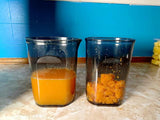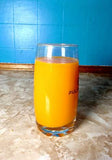Credit: https://discover.hubpages.com by WALTER SHILLINGTON
Healthier Foods
I drink six cups of coffee every day. I love the taste, and the caffeine keeps me alert during the tedious but necessary editing associated with my work.
Unfortunately, I’ve reached the age where I need to mix a few healthier alternatives into my usual diet of fried chicken, Kraft dinner, and coffee.
Today, I am testing a device that squashes fruit and vegetables, separating the pulp from the liquids. It will turn apples into apple juice and reduce oranges to a delicious nectar. It can even convert perfectly good carrots into carrot juice for those so inclined.



Cleaning brush
Description
The AMZCHEF Slow Juicer looks like an exceptionally tall blender sheathed in black plastic. It weighs 10.23 pounds and is 6.5 inches wide, 7.5 inches deep, and 17.25 inches high when fully assembled.
Enclosed within the juicer’s base is a 250W motor that turns the device’s squeezing auger. Its power cord exits through the back, just below a switch that turns the juicer on and, if required, reverses the motor’s direction.
The middle section houses the device’s removable squeezing auger. As the plastic blade rotates, it draws ingredients like fruit and vegetables downward and mashes them against the side of its container. The resulting pulp is directed toward the pulp spout, and the juice will remain within the unit until the juice spout is opened. Containers used to collect the dripping juice and pulp are included with this device.
The upper section consists of a semitransparent feeding chute boasting a 5.3-inch opening and a storage capacity of 63 liquid ounces. The ingredients filling this compartment will be drawn downward toward the squeezing auger as the juicer operates.
The lower rim of this section is fitted with a triple metal mesh filter designed to keep the juice flowing smoothly.



The base is fitted with suction cup-style feet


The squeezing auger
Specifications
- Brand: AMZCHEF
- Type: Slow juicer
- Model: SJ-036
- Weight: 4.64 kilograms (10.23 pounds)
- Dimensions: 43.8 x 15.5 x 19 centimeters (17.25 x 6.5 x 7.5 inches)
- Power requirement: 120VAC
- Drive motor: 250W
- Feed chute opening: 135 millimeters (5.3 inches)
- Feed chute capacity: 1.8 liters (63 fluid ounces)
- Motor reverse control: Yes
- Mesh filter: 2mm, 0.8mm, and 0.5mm
- Nut milk capable: Yes
- Package contents: Juicer, pulp container, juice container, cleaning brush, pushing device, and user guide

The feeding cup

The base and auger assemblies
Setup
The juicer arrived almost fully assembled. I removed the various parts, washed them in warm water, and put them back in place.

test ingredients
The Celery Test
The manufacturer recommends cutting fruit and vegetables into strips or squares approximately one-half by one inch thick and removing all hard seeds. This protects the motor from overexertion and the auger from possible damage. In addition, smaller-sized ingredients will be fed into the auger without needing constant prodding with the pushing device.
I chopped my celery into half-inch strips, overfilling a 28-ounce plastic storage container. I then poured the chopped celery into the juicer’s feeding chute and closed the lid.
Over a five-minute period, the churning auger reduced the celery to a damp, pulpy mess that slid from the pulp spout into a plastic container.
When I opened the juice spout, over 11 ounces of bright green liquid poured into the juice container. The juice was pulp-free and tasted like celery. If you like celery—and I don’t—you will love this juice.

The celery test




The celery test
The Carrot Test
After quickly cleaning the various parts of the juicer, I reassembled the device. Then, I cut up enough carrots to fill my 28-ounce plastic container.
Once I’d transferred the carrots to the juicer’s feeding chute, I turned it on and waited as it mashed the vegetable, separating it into juice and a pulp substantially dryer than the celery.
Because carrot pulp is very fine, a small amount was mixed within the liquid produced by this device. I won’t complain, though, as the pulp improved the taste of my juice. The total yield was 7.7 ounces.

The carrot test




The carrot test
The Apple Test
I cleaned the juicer again and cut up enough apples to fill my 28-ounce container. Since fruit tends to be softer than vegetables, I was less concerned about the size of each slice.
Some of the half-mashed apple fragments tried to escape the deadly auger by plastering themselves against the edge of the container. Due to this act of cowardness, it took a couple of extra minutes to extract the 11.5 ounces of tasty apple juice fully.

The apple test




The apple test
The Orange Test
After cleaning the juicer, I peeled several clementines and separated them into individual sections. Then, I poured them from my 28-ounce container into the juicer’s feed chute.
Like the apples and celery, the resulting pulp was damp. However, my efforts were rewarded by 14 ounces of delicious orange juice.

The orange test




The orange test
The Pineapple Strawberry Test
The precut pineapple chunks I purchased did not entirely fill my 28-ounce storage container. I made up the difference by adding a handful of plump strawberries.
As with some of my other ingredients, the pineapple pulp tended to retain moisture. The 12 ounces of juice this device produced, however, was excellent. In the future, I will often combine pineapple and strawberries in this juicer.

The pineapple-strawberry test




The pineapple-strawberry test
Overall Impression
The most significant selling point of this masticating juicer is convenience. Because it is equipped with a large feeding cup, it is not necessary to constantly add ingredients.
Varying amounts of moisture were retained in the pulp of some of the fruits and vegetables I processed. While a juice press is better than a masticating juicer at extracting pulp from juice, these devices are much more expensive.
Cleanup is easy, although pushing out the pulp trapped in the pulp spout’s rubber gasket can be a pain.
If you are looking for a juicer capable of extracting lots of tasty juice from fruits and vegetables, I recommend the AMZCHEF Self-Feeding Masticating Juicer.
You might also like: I just tested this value-priced cold press juicer — and it's shockingly good





